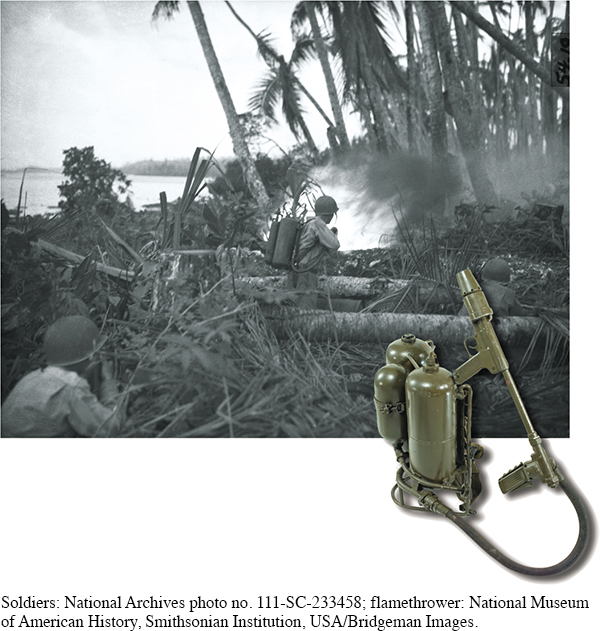The American Promise: Printed Page 726
The American Promise, Value Edition: Printed Page 661
The American Promise: A Concise History: Printed Page 753
Chapter Chronology
In the Pacific theater, Japan’s leading military strategist, Admiral Isoroku Yamamoto, believed that if his forces did not quickly conquer and secure the territories they targeted, Japan would eventually lose the war because of America’s far greater resources. Swiftly, the Japanese assaulted American airfields in the Philippines and captured U.S. outposts on Guam and Wake Island. After capturing Singapore and Burma, Japan sought to complete its domination of the southern Pacific with an attack in January 1942 on the American stronghold in the Philippines (see Map 25.5). American defenders surrendered to the Japanese in May. The Japanese victors sent captured American and Filipino soldiers on the infamous Bataan Death March to a concentration camp, causing thousands to die. By the summer of 1942, the Japanese had conquered the Dutch East Indies and were poised to strike Australia and New Zealand.
In the spring of 1942, U.S. forces launched a major two-pronged counteroffensive that military officials hoped would reverse Japanese advances. Forces led by General Douglas MacArthur, commander of the U.S. armed forces in the Pacific theater, moved north from Australia and eventually attacked the Japanese in the Philippines. Far more decisively, Admiral Chester W. Nimitz sailed his battle fleet west from Hawai’i to retake Japanese-held islands in the southern and mid-Pacific. On May 7–8, 1942, in the Coral Sea just north of Australia, the American fleet and carrier-based warplanes defeated a Japanese armada that was sailing around the coast of New Guinea.

Flamethrower in Combat in the Solomon Islands American soldiers used flamethrowers in both the Pacific and European theaters. They were especially effective against enemy soldiers dug into bunkers that were difficult to penetrate by rifle or machine-gun fire. The Marine shown here, fighting in the Solomon Islands in 1943, carried on his back canisters of jellied gasoline and compressed air that were combined and projected through the gunlike machine.
Soldiers: National Archives photo no. 111-SC-233458; flamethrower: National Museum of American History, Smithsonian Institution, USA/Bridgeman Images.
Nimitz then learned from an intelligence intercept that the Japanese were massing an invasion force aimed at Midway Island, an outpost guarding the Hawai’ian Islands. Nimitz maneuvered his carriers and cruisers to surprise the Japanese at the Battle of Midway. In a furious battle that raged on June 3–6, American ships and planes delivered a devastating blow to the Japanese navy. The Battle of Midway reversed the balance of naval power in the Pacific and put the Japanese at a disadvantage for the rest of the war. Japan managed to build only six more large aircraft carriers during the war, while the United States launched dozens, proving the wisdom of Yamamoto’s prediction. But the Japanese still occupied and defended the many places they had conquered.
